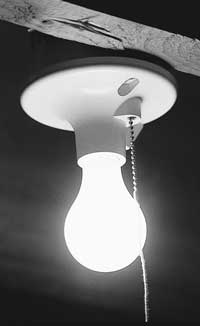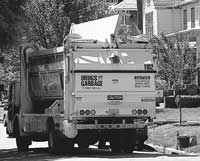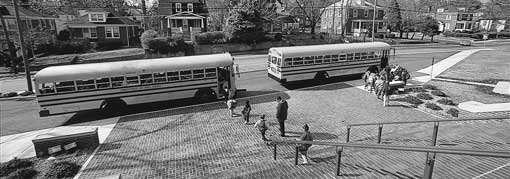|
Unit 4: Your home
is your castle
Lesson 1: Protecting and maintaining
your home
Finally, the hard work of buying your
home is behind you! But as moving day gets closer, there
are new things to think about. Setting up your new home
can be fun,
but it will be a lot easier if you get organized!
This lesson will tell you some of the
things you will need to do to protect and maintain your
new home. To help you learn about the many things to consider,
let’s look at what Sue Johnson did before she and her
mother moved into their new condo.
Getting to know your major systems
When she was shopping for a home, Sue
Johnson learned a little about the major systems such as
the electrical, plumbing, heating, and cooling systems.
But now she was worried. Would she know how to operate each
one?
 During
the building inspection for her home, she talked to the
building inspector, Bill Moore, about her concerns. One
of the most important things, he told her, was to know how
to turn off the systems safely if things went wrong. Then
you could always call someone to make the repairs. The second
thing, he said, was to know how to operate the systems to
save the most energy. During
the building inspection for her home, she talked to the
building inspector, Bill Moore, about her concerns. One
of the most important things, he told her, was to know how
to turn off the systems safely if things went wrong. Then
you could always call someone to make the repairs. The second
thing, he said, was to know how to operate the systems to
save the most energy.
First, he showed her the fuse box. In
her condo it was located in a bedroom. Newer houses, he
explained, had circuit breakers instead of fuses. He showed
her where the main electrical switch was. It turns
off all the electricity in the condo.
Next, he took her out to the front yard
and pulled up a metal plate on the ground. Inside was the
main water shut-off valve to the condominium building.
“If a pipe bursts or you can’t stop the water
running from a faucet,” Bill told Sue, “you can
turn off the water in the whole building by turning off
the main shut-off valve.”
Finally, he took her down to the basement
of the condominium building to show her the gas shut-off
valve. “If you smell gas around your stove,” he
warned her, “don’t wait to turn off the gas shut-off
valve. Just turn off the stove and go to a neighbor or public
phone to call 911. It’s too dangerous to be in a home
with gas fumes.”
Bill also showed Sue how to operate her
furnace, air conditioner, and hot water heater. He showed
her how to adjust the settings to save the most energy.
He also advised her to get a thermostat
that is on a timer. A thermostat measures the heat and cold
in the house. That way, if she and her mother are away all
day, she can set the timer to warm up (or cool down) the
house just before they get home, instead of keeping it heated
(or cooled) all day.
Finally, Bill checked to see that all
the smoke alarms were working. “You should have
at least one on every floor,” he told her. He also
suggested that she get a fire extinguisher for the
kitchen and one for the second floor.
Keeping your manuals and warranties
During the final walk-through inspection,
Sue made sure to ask the owner if he had left all the manuals
and warranties for the appliances. Sure enough, he had each
of them ready for her, including ones for the refrigerator,
stove, air conditioner, hot water heater, and others.
Each of the appliances, he told her, had
come with both a manual and a warranty. The manuals explain
how to operate the appliances properly. The warranty guaranteed
free parts and service for a certain amount of time. The
Document literacy section on this page
describes warranties and how to use them.
 Local
collection services Local
collection services
Sue also asked the owners about garbage,
recycling, and leaf collection. In Sue’s area, garbage
collection is on Mondays and Thursdays. She has to make
a special call if she has something bigger to have picked
up, such as an old sofa or appliance.
Utilities
Sue’s real estate agent had a list
of the utility companies she would need to call to continue
service. Well in advance of her move, she notified the electricity,
water, and gas companies of a date to turn on services.
Sue gave them her name, her address, a phone number where
she could be reached, her employer’s name and address,
and the day she wanted the service turned on. Sue also called
the phone company. They told her about many extra services.
To save money, she decided not to get extra services at
first and to decide later if she really needed them. For
long distance, Sue had a choice of many different companies.
She decided on the one that gave her the best rates.

Finding out about nearby services
Sue wanted to get to know some of her
neighbors. She also wanted to find out about nearby services.
She decided to ask her new next-door neighbor, Mrs. Evans,
about services in the area. The next time she saw Mrs. Evans
in the hallway, she introduced herself.
Mrs. Evans told Sue about the nearest
hospital, the library, the park, and a good recreation center
for seniors that her mother might be able to attend. She
also told her which pharmacies and grocery stores had the
best prices.
Sue wanted to continue her education,
so she called the main number for the public schools and
asked where she could take adult education classes. The
adult education office gave her the location for adult evening
classes nearest her condo. Now she was beginning to feel
much more “at home.”
 Making
a house file and storing documents Making
a house file and storing documents
One week after she moved in, Sue already
had a large pile of manuals, receipts, and other documents.
She knew she had to do something! So, she went to the office
discount store and bought a large cardboard box for storing
files and a box of file folders. She made a file for each
of her appliances and utilities. She made other files for
her mortgage payment forms, her homeowner’s insurance,
and other forms. Sue put them in alphabetical order. Now
she had an organized system to keep her important papers
and receipts after she paid each of her bills.
While she was at the store, she also got
a fireproof strong box. In this box, she put the title to
her house, her homeowner’s insurance policy, and all
her other important documents. She knew if there was time
during an emergency, this was the box she would take out
of the house first. After she was finished, Sue felt much
better. Now she could find things when she needed them!
Previous
Page | Next Page
|